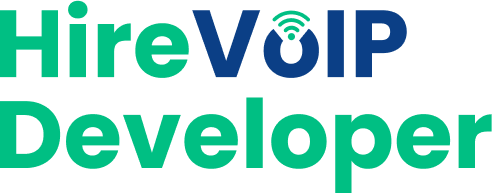📝 Blog Summary
This blog explains how to grow UCaaS platforms smoothly, overcome common challenges, and leverage Hire VoIP Developer for secure, efficient, and disruption-free communication.
Your UCaaS solution promised seamless communication, but the reality is different.
❌ Calls cut out.
❌ messages get lost.
❌ Remote teams struggle to stay connected.
❌ IT is overwhelmed, and
❌ productivity takes a hit.
But scaling your business shouldn’t come with these headaches!
As your organization grows, adding users, expanding to new locations, or supporting remote teams can put a serious strain on your existing communication systems. The real challenge lies in scaling your UCaaS platform without disrupting the IT infrastructure you’ve already built.
This is where you need custom UCaaS solutions!
Did You Know?
The global UCaaS market is projected to grow from USD 70.50 billion in 2024 to USD 433.29 billion by 2034, expanding at a CAGR of 18% from 2025 to 2034.
Here is how to strategize for adopting a scalable UCaaS solution, one that grows with your business while keeping your current systems intact.
But first, let’s understand the common challenges businesses face when expanding their UCaaS systems.
What are the Challenges of Scaling UCaaS Without Affecting Existing Infrastructure?
When a business grows, its communication setup often starts to feel the pressure. What once worked perfectly for a small team may suddenly begin to slow down, crash, or clash with other systems. Scaling a UCaaS platform isn’t just about adding more users or features; it’s about making sure everything continues to work together without breaking what’s already running well.
One of the biggest challenges is dealing with older systems. Many companies still use on-premise PBX or legacy servers, and these don’t always blend easily with modern cloud setups. A small mismatch here can cause call drops or sync issues if not handled carefully.
Another common issue is the network itself. As usage grows, more calls, more video meetings, more data sharing, the network and bandwidth have to keep up. Without enough capacity, communication slows down, and the experience suffers.
Then there’s security. Scaling often means more users and more access points, which automatically means more room for errors or breaches if not managed well.
And finally, people. When new tools or features are rolled out too quickly, teams struggle to adapt. Without proper guidance or time to adjust, even a good system can feel like a burden.
All of this means one thing: scaling UCaaS needs planning. When it’s rushed, existing systems can easily break under pressure. However, when done carefully, it sets the foundation for smooth, uninterrupted growth, especially as the impact of AI on unified communication influences how UCaaS platforms scale.
Now, let’s look at practical strategies to grow your communication system without disruption.
🔧 Need Help Scaling UCaaS Systems Smoothly? Hire Experienced Developers Now!
What are the Key Strategies to Scale UCaaS Seamlessly
Scaling isn’t that complicated. With the right approach, you can grow your communication system without causing downtime or frustrating your teams.
Here are some practical strategies to make it happen:
1. Use a hybrid setup when needed
Not every business is ready to move entirely to the cloud. A hybrid approach, combining cloud UCaaS with your existing on-premise systems, lets you expand gradually while keeping critical operations running smoothly.
2. Make integrations a priority
Your UCaaS platform should work well with the tools your teams already use, CRM, ERP, or collaboration apps. Proper integration prevents disruptions and ensures information flows seamlessly across systems.
3. Take advantage of cloud flexibility
Modern UCaaS platforms are designed to scale up or down based on demand. This means you can add new users or locations without overloading your network or infrastructure.
4. Roll out changes in phases
Instead of switching everything at once, introduce new features, users, or locations step by step. This makes it easier to spot and fix issues before they affect everyone.
5. Prepare your network
Check your bandwidth, optimize your network, and set up quality-of-service measures to handle increased traffic. A strong network foundation keeps calls clear and meetings smooth, even as usage grows.
Beyond strategies, following clear best practices and understanding the what, why, and how of each step helps ensure that every expansion is safe, efficient, and supports an optimized customer experience with unified communications.
Best Practices for Ensuring UCaaS Scalability
Keeping your communication systems reliable while expanding requires careful planning and smart practices.
Following proven steps ensures smooth performance, minimal disruption, and long-term efficiency.
1. Assess your current setup
What: Start by evaluating your existing UC and network environment.
Why: You can’t scale what you don’t fully understand, and knowing what’s already in place prevents costly disruptions later.
How: Take stock of every component (like PBX, servers, and integrations), check network health, and record key performance metrics to identify what needs upgrading before you expand.
2. Set clear goals and monitor performance
What: Define measurable goals before you start scaling.
Why: Without clear KPIs, it’s impossible to know whether your system is improving or breaking under pressure.
How: Choose a few performance metrics, such as uptime, call quality, and response time, and review them regularly through dashboards or reports to ensure progress stays on track.
3. Choose the right vendor and lock in SLAs
What: Partner with a UCaaS provider who supports flexible scaling and backs it with solid SLAs.
Why: A reliable vendor minimizes the risk of downtime and ensures accountability when issues arise.
How: Evaluate vendors through short pilots, review their support responsiveness, and ensure your SLA includes performance guarantees and escalation procedures that protect your business.
4. Plan for security and compliance
What: Integrate security into every step of your scaling plan.
Why: More users and endpoints mean more opportunities for data breaches and compliance failures.
How: Strengthen access controls, enforce encryption, and review compliance gaps before expanding access to new users or locations. Prevention here saves far bigger problems later.
5. Train people and roll out in phases
What: Introduce new tools gradually and ensure your teams know how to use them.
Why: Even the best UCaaS upgrade fails if users struggle to adapt or feel left behind.
How: Start with a pilot rollout for a small group, gather feedback, fix early issues, and expand step by step while running short, role-specific training sessions to ease adoption.
While these practices provide a framework, partnering with the right provider, like Hire VoIP Developer, can make scaling even smoother and risk-free.
How Hire VoIP Developer UCaaS Solutions Help Businesses Scale Without Disruption
Scaling communication shouldn’t mean rebuilding everything from scratch, and that’s exactly what Hire VoIP Developer UCaaS solutions ensure. With deep expertise in custom UCaaS design and hybrid deployments, we help businesses grow without disturbing their existing systems.
Here’s how Hire VoIP Developer makes scaling seamless:
✅ Smooth integration with existing infrastructure: Our platforms connect effortlessly with on-prem PBX, SIP servers, and legacy tools, ensuring zero communication gaps.
✅ Hybrid flexibility: Whether you’re partly cloud or fully on-prem, our UCaaS architecture adapts to your environment instead of forcing a complete migration.
✅ Business benefits: Minimal disruption, better cost efficiency, and built-in security and compliance to protect sensitive communications.
With Hire VoIP Developer, scaling your UCaaS platform becomes less about risk and more about readiness for the next stage of growth.
With the right platform and approach, businesses can expand communication capabilities confidently.
Here’s the final takeaway.
🧩 Unlock Seamless UCaaS Expansion
The Bottom Line?
Scaling UCaaS isn’t just about adding capacity; it’s about ensuring your communication backbone grows without breaking what already works. The key lies in careful planning, seamless integration, and choosing a solution that adapts to your infrastructure, not the other way around.
Businesses and organizations should focus on UCaaS platforms that bring flexibility, security, and interoperability together, so business growth never comes at the cost of disruption.
Key Takeaways
- Scalable UCaaS systems prevent performance issues and downtime during business expansion.
- Smooth integration with existing infrastructure reduces cost and migration complexity.
- Partnering with an experienced provider like Hire VoIP Developer ensures secure, compliant, and future-ready growth.
Looking to scale without disruption? Contact us to explore scalable UCaaS solutions tailored to your business needs.


